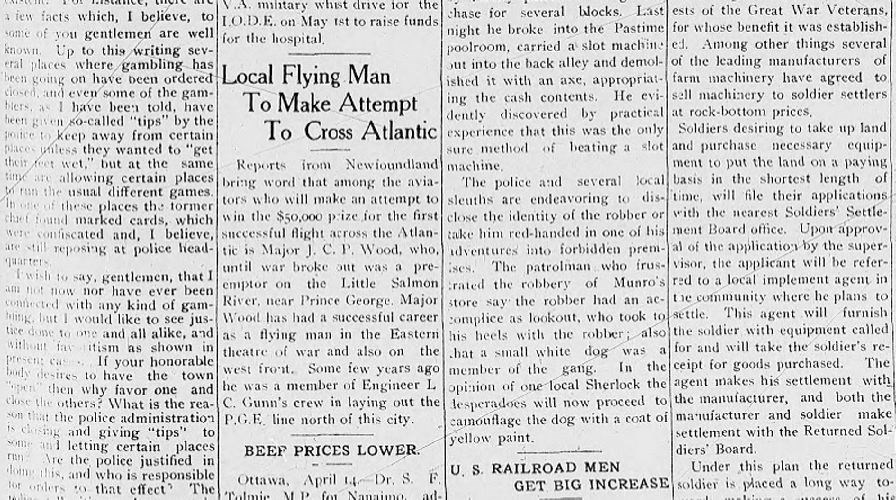This week in Prince George history, April 10-16:
April 16, 1919: "Local flying man to make attempt to cross Atlantic," said a headline in the Prince George Citizen.
"Reports from Newfoundland bring word that among the aviators who will make an attempt to win the $50,000 prize for the first successful flight across the Atlantic is Major J.C.P. Wood, who until the war broke out was a preemptor on the Little Salmon River, near Prince George," The Citizen report said. "Major Wood has had a successful career as a flying man in the Eastern theatre of war and also on the west front. Some few years ago he was a member of Engineer L.C. Gunn's crew in laying out the P.G.E. line north of the city."
The cash prize was offered by The Daily Mail newspaper of London for the first flight from any point in the U.S., Canada or Newfoundland (still a British colony at the time) to any point in Great Britain or Ireland in 72 continuous hours.
Unfortunately Major Wood didn't win it in his Short biplane, the Shamrock. John Alcock and Arthur Brown won the prize in June 1919, after flying from St. John's to Galway, Ireland in just under 16 hours in a modified Vickers Vimy twin-engine bomber.
I couldn't resist finding out what happened to Major Wood, who was the first person to make an attempt at winning The Daily Mail prize. Thankfully I was able to find the answer in the archives of the New York Times from April 20, 1919:
Wood and his navigator, C.C. Wylie, left Eastchurch, England at 3:15 p.m. on April 18 in the Shamrock, their Short biplane, the Times reported. Lancaster Parker departed with them in an escort plane.
Wood and Wylie were headed to Limerick, Ireland with the intent of flying from Limerick to St. John's.
"Later authentic word came that the aviator and his navigator and plane had fallen into the Irish Sea near Holyhead, about 7 p.m. and had been rescued," the Times reported.
Sidney Goodchild and Captain Williams were with a group picnicking on the shore when they saw the plane go down.
"We were with a party walking on the shore when we saw two airplanes. One was in difficulty and came down on the water. Crowds flocked to the shore. We found a row boat and, after great difficulty, reached the airplane. The boat could only hold one of its two occupants. This was Major Wood. He looked very black and used the words 'The Atlantic flight is pipped,'" the Times quoted Goodchild as saying. "Our little boat swamped before we reached the shore, the three of us having to wade up to our waists. The other airplane tried to come down but got badly smashed against the wall. It's only occupant escaped uninjured. We saw a lifeboat go to the rescue of the other man (Wylie), bringing him safely to shore."
Wood developed engine trouble off the Isle of Anglesey, Wales and was forced to put his plane down in the ocean, the Times reported. A destroyer called the Paisley attempted to tow the crashed plane ashore, but was forced to abandon it and the Shamrock washed ashore on the beach.
"Both officers are more concerned about their machine than themselves, but it was impossible for me to bring the biplane into the harbour," the Times quoted Paisley's commander as saying.
In a message to The Weekly Dispatch, Wood said he was still a competitor and intended to repair Shamrock and make a second attempt. Clearly Wood's unlucky Shamrock wasn't ready before Alcock and Brown's successful flight on June 14, 1919.
So that's the story of how a Prince George man's attempt to make history got pipped.
April 15, 1921: There was big trouble in Prince George's Chinatown, The Citizen reported.
A feud between the members of the Chinese Nationalist League and the Chee Kong Tong boiled over into a street brawl just off Third Avenue on April 8, 1921, The Citizen reported. A dozen people were arrested and one man was in hospital after being shot with a revolver in the leg.
Chee Kong Tong members Ken Nang, Wong Young, Chew Chong, Henry Fai and Wong Duck appeared in court on April 14, 1921 and were committed to go ahead to trial. Won Hon Son was acquitted for lack of evidence.
Members of the rival Chinese Nationalist League were to appear in court on April 15, 1921.
Prominent members of the Nationalist League told The Citizen that the Chee Kong Tong were engaged in gambling and opium smoking, something they vigourously opposed, and the group was bringing in "tough guys" from Vancouver to intimidate Nationalist League members.
However, Chee Kong Tong members said a Nationalist League member had recently assaulted one of their members, but wasn't convicted, and League members had distributed pamphlets making defamatory statements about one of the Chee Kong Tong members.
In addition, the Chinese Nationalist League were strong supporters of revolutionary leader Sun Yat-Sen. The Chee Kong Tong said Sun Yat-Sen was a former member of their organization, and they had nothing against him or his supporters, The Citizen reported.
The early 20th century was a time of convoluted politics in China. The overthrow of the Qing (sometimes also called the Manchu) Dynasty of the Chinese Empire in 1912 resulted in years of unrest and violent conflict, which radiated out to the Chinese disporia living in Canada and elsewhere.
Kuomintang Party founder Sun Yat-Sen, and his successor Chaing Kai-shek, would eventually solidify control of China to form the Republic of China. The Republic would be overthrown in 1949 by communist forces, but the Kuomintang remains a powerful political force in Taiwan.
To explore 100 years of local history yourself, visit the Prince George Citizen archives online here. The Prince George Citizen online archives are maintained by the Prince George Public Library.



